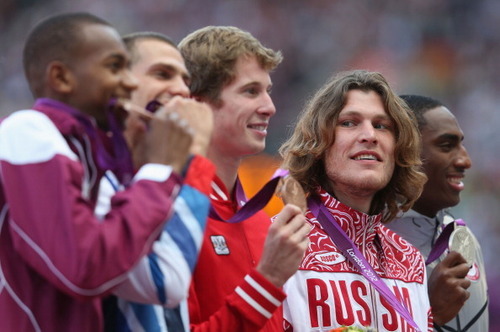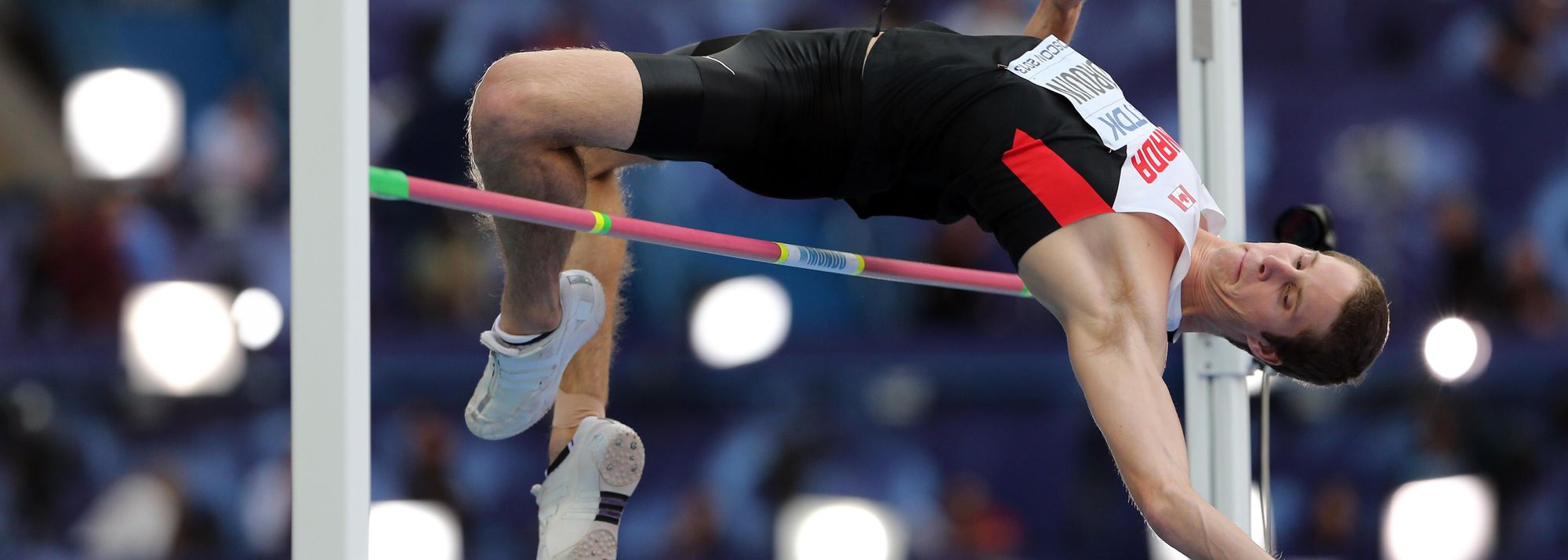Derek Drouin Canadian high jumper
Derek Drouin was one of the star cast in a stellar high jump final at the Moscow 2013 World Championships this summer. We speak to the Canadian record holder about clearing 2.40m, and the unconventional training methods he’s using to do it.
Just what is it about world-class high jumpers and their slightly quirky training methods? Earlier this year we revealed that Ivan Ukhov hardly jumped, or did much exercise at all, for months after winning Olympic gold.
Now, we give you Moscow bronze medallist Derek Drouin, 23, who spends just as much time hurdling, shot putting and long jumping as he does high jumping.
He even competes in the odd indoor heptathlon, too.
“I think I would get bored training for the same event,” says Drouin, in his soft Canadian drawl. “It has been really good for me. A lot of people who do just one event get hurt because of the repetition.
“I refrain from doing repetitive motions all the time and this has helped me not to get hurt. By practising the other events I can translate that speed to takeoff and my entire body is always active and getting a good workout. I can’t foresee changing this approach any time soon.”
In a season where high jump has emerged as arguably the stand-out event in track and field, the man from Corunna, Ontario has been at the forefront of its resurgence.
Like many athletes, Drouin benefitted from having an athletic family. His older sister Jillian was good enough to finish sixth in the high jump at the 2010 Commonwealth Games.
He was exposed to the sport from a young age.
"Drouin recalls first high jumping in the basement by using a couch for a mat, music speakers and books for the stands, and a broomstick for the bar."
His early years were dominated, like so many Canadian youngsters, by the sport of ice hockey and he only dabbled in athletics, principally as a hurdler. It was only when he experienced a growth spurt aged 16 that he started taking high jump more seriously.
Within a year he was good enough to make the Canadian team, and finished tenth in high jump at the world youth champs.
In the fall of 2008 he headed south to attend the University of Indiana. By the end of his first full year in the US he had advanced his personal best by a monster 0.16 to a Canadian junior record 2.27m.
In 2010 he landed NCAA titles, indoors and out.
“I was a late bloomer and the decision to go to Indiana is when I really grew up,” says Drouin, whose father is French and mother is a Canadian, of Scottish and German extraction.
“I looked like a little boy when I went to Indiana. But there was a whole lot of factors as to why I improved. I started to mature physically, I was getting great coaching, and for the first time I was fully concentrating on track and field.”
The serene journey of progression came to a shuddering halt shortly after he retained his NCAA indoor title in March 2011. Competing in a Big Ten college meeting in Starkville, Mississippi he tore two ligaments in his foot.
The injury known as Lisfranc is a notorious career-ending injury for many athletes, and the road to full recovery for Derek was grindingly slow.
“There were some doubts and some dark days,” he says. “One of the biggest mistakes I made was, during the rehab, looking up more about the injury.
“After finding out the seriousness of the injury I broke down and rang my sister. She did an incredible job of calming me down and reassuring me.
“After that day I never broke down again. My main goal before the injury was the Olympic Games and that never changed.”
After more than a year away from competing, the relentlessly positive high jumper returned to competition in March last year. Five months later he landed a bronze (along with Robbie Grabarz and Mutaz Essa Barshim) by clearing 2.28m at the London Olympics.

Five men, one podium: Olympic HJ medallists (L-R) Barshim, Grabarz, Drouin, Ukhov & Kynard.
“My entire life, I’d seen those montages of athletes competing at the Olympic Games and I always felt so emotional for the athletes. I couldn’t believe it actually happened to me.”
Drouin, who is coached by Jeff Huntoon, was still far from satisfied. Completely aware the standard of the Olympics “wasn’t very strong” – he had a desire to prove his medal was no fluke.
In 2013, he regularly competed in the 60m hurdles (PB 7.98) and 110m hurdles (PB 14.04) in the early season, and did one indoor heptathlon. In March, Drouin showed he was in the form of his life by setting a Canadian indoor HJ record of 2.35m for his third indoor NCCA gold.
Outdoors, he set a Canadian record 2.36m in Eugene, and secured his second outdoor NCAA crown in June. The following week, he turned pro.
In Moscow, the Ontarian played his part in the most high-class championship high jump competition in history, winning world bronze with 2.38m. That height would have been good enough for HJ gold at the previous nine editions of the IAAF World Championships.
Unfortunately, Bohdan Bondarenko jumped higher, with a stunning 2.41m. And Mutaz Ezza Barshim, who also cleared 2.38m, took silver on count-back.
“I joked afterwards, who jumps 2.38m and only gets bronze? To be involved, though, in a final like that, was something.
“I was incredibly proud to be a part of the resurgence of high jumping. It was huge turnaround on London. I was very happy to have cleared 2.38m, but I wanted to win.
“There is a difference between clearing the bar and winning. Looking back I wish I could have cleared 2.40m.”
Next season, the 2014 World Indoor Championships remain a tantalising early season prospect, and Drouin’s main championship goal is winning Commonwealth gold in Glasgow.
Yet there are two bigger targets for 2014: to join that exclusive club of nine athletes to have cracked 2.40m, and finding a way to stop Bondarenko…
“Bohdan is doing something that works for him, and I have to do whatever I can to reach his level,” says Drouin.
“Now I’m no longer at college I can experiment with my training. I’m pleased for the opportunity to do that, but I’ll definitely be looking to take him down next season.”




